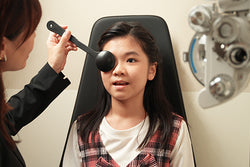
Common Causes of Red Eyes in Contact Lens Wearers
- Overwearing of contact lenses: Wearing contact lenses for longer than the recommended amount of time can deprive the eyes of oxygen and lead to red eyes1.
- Sleeping with contact lenses on: Sleeping in contact lenses can increase the risk of infection and lead to red eyes2.
- Low oxygen levels or poorly fitted contact lenses: Contact lenses that are too tight or made from materials that do not allow enough oxygen to reach the cornea can cause red eyes3.
- Allergic reaction: Allergic reactions to contact lens solution, cleaning products, or the contact lenses themselves can cause red eyes4.
- Dry eyes: Dry eyes are a common condition that can be exacerbated by contact lens wear. This can lead to red eyes, discomfort, and blurred vision5.
- Poor contact lens and/or case hygiene: Poor contact lens and case hygiene can increase the risk of infection and lead to red eyes6.
- Eye infection/inflammation: Eye infections and inflammation can cause red eyes, pain, and discharge7. A common eye inflammation is CLARE (Contact Lens Acute Red Eye).
- Corneal ulcer: A corneal ulcer is a lesion on the cornea, the clear layer at the front of the eyes. It can be caused by infection, trauma, or severe dry eyes8. Corneal ulcers can be serious and require prompt treatment to prevent vision loss.
Contact Lens Acute Red Eye (CLARE)
CLARE is an inflammatory reaction of the cornea and conjunctiva associated with overnight contact lens wear9. It is caused by a combination of factors, including hypoxia (oxygen deprivation), inflammation, and mechanical irritation10. Symptoms of CLARE include red eyes, pain, light sensitivity, and contact lens intolerance11. CLARE commonly occurs in those who wear lenses to sleep overnight and may occur in one or both eyes. While CLARE usually resolves on after temporary cessation of contact lens wear and therapeutic treatment12, it may recur if non-compliant with proper lens care regime.
Preventing Red Eyes While Wearing Contact Lenses
There are a number of things you can do to prevent red eyes while wearing contact lenses:
- Follow the recommended wearing schedule for your contact lenses.
- Do not sleep in your contact lenses.
- Wear contact lenses that fit well and are made from a material that has high oxygen permeability.
- Avoid wearing contact lenses if you have an allergic reaction.
- Lubricate your eyes regularly with rewetting eye drops to alleviate symptoms of dry eyes.
- Practice good contact lens and case hygiene.
- See your optometrist for regular checkups and contact lens fittings.
When to Seek Urgent Treatment
While red eyes in contact lens wearers can be due to various factors, understanding the underlying cause is essential for effective management. If you experience sudden redness or discomfort, it is crucial to discontinue lens wear and consult your eye care professional promptly.
Our eye care professionals are able to advise you on maintaining your eye health. Book your comprehensive eye exam here and enjoy clearer and healthier vision.
1. “Contact Lens Overwear” Asia Retina. https://asiaretina.com/contact-lens-overwear/
2. “Eye Infections From Contact Lenses” American Academy of Ophthalmology. https://www.aao.org/eye-health/diseases/contact-lens-related-eye-infections
3. Barba Gallardo LF, Muñoz Ortega MH, Ventura Juarez J, Aldaba Muruato LR, Sánchez Alemán E, Valdez Morales EE, Blancas Zugarazo SS, Villafan Bernal JR. Extended low oxygen transmissibility contact lens use induces alterations in the concentration of proinflammatory cytokines, enzymes and electrolytes in tear fluid. Exp Ther Med. 2018 May;15(5):4291-4297. doi: 10.3892/etm.2018.5989. Epub 2018 Mar 22. PMID: 29849773; PMCID: PMC5962872.
4. “Contact Lenses: When a Solution Is the Problem” American Academy of Ophthalmology. https://www.aao.org/eyenet/article/contact-lenses-when-solution-is-problem
5. “Dry Eye” National Eye Institute. https://www.nei.nih.gov/learn-about-eye-health/eye-conditions-and-diseases/dry-eye
6. Cope JR, Collier SA, Nethercut H, Jones JM, Yates K, Yoder JS. Risk Behaviors for Contact Lens-Related Eye Infections Among Adults and Adolescents - United States, 2016. MMWR Morb Mortal Wkly Rep. 2017 Aug 18;66(32):841-845. doi: 10.15585/mmwr.mm6632a2. PMID: 28817556; PMCID: PMC5657667.
7. “Eye Infections From Contact Lenses” American Academy of Ophthalmology. https://www.aao.org/eye-health/diseases/contact-lens-related-eye-infections
8. “What Is a Corneal Ulcer (Keratitis)?” American Academy of Ophthalmology. https://www.aao.org/eye-health/diseases/corneal-ulcer
9. “Bringing Clarity to CLARE” Review of Cornea and Contact Lenses.https://www.reviewofcontactlenses.com/article/bringing-clarity-to-clare
10. “Managing Contact Lens-associated Red Eye” Review of Cornea and Contact Lenses. https://www.reviewofcontactlenses.com/article/managing-contact-lensassociated-red-eye
11. “Bringing Clarity to CLARE” Review of Cornea and Contact Lenses.https://www.reviewofcontactlenses.com/article/bringing-clarity-to-clare
12. “Diagnosing and Managing Lens-Related Complications” Contact Lens Spectrum. https://www.clspectrum.com/issues/2010/march-2010/diagnosing-and-managing-lens-related-complications
← Older Post Newer Post →




